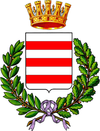Ravello
| Ravello | ||
|---|---|---|
| Comune | ||
| Comune di Ravello | ||

Amalfi Coast looking south from Ravello
|
||
|
||
| Location of Ravello in Italy | ||
| Coordinates: 40°39′N 14°37′E / 40.650°N 14.617°E | ||
| Country | Italy | |
| Region | Campania | |
| Province / Metropolitan city | Salerno (SA) | |
| Frazioni | Sambuco, Torello, Castiglione, Marmorata, San Cosma, San Pietro alla Costa, Monte, Casa Bianca | |
| Government | ||
| • Mayor | Salvatore Di Martino | |
| Area | ||
| • Total | 7.94 km2 (3.07 sq mi) | |
| Elevation | 365 m (1,198 ft) | |
| Population (31 December 2014) | ||
| • Total | 2,500 | |
| • Density | 310/km2 (820/sq mi) | |
| Demonym(s) | Ravellesi | |
| Time zone | CET (UTC+1) | |
| • Summer (DST) | CEST (UTC+2) | |
| Postal code | 84010 | |
| Dialing code | 089 | |
| Patron saint | St. Pantaleon | |
| Saint day | July 27 | |
| Website | Official website | |
Ravello is a town and comune situated above the Amalfi Coast in the province of Salerno, Campania, southern Italy, with approximately 2,500 inhabitants. Its scenic location makes it a popular tourist destination, and earned it a listing as a UNESCO World Heritage Site in 1996.
Ravello was founded in the 5th century as a shelter place against the barbarian invasions which marked the end of the Western Roman Empire. In the 9th century Ravello was an important town of the maritime republic of Amalfi, a producer of wool from its surrounding country that was dyed in the town and an important trading power in the Mediterranean between 839 and around 1200.
In 1086. at the request of the Norman count Roger Borsa, who wished to create a counterweight to powerful Amalfi, Pope Victor III made Ravello the seat of a diocese immediately subject to the Holy See, with territory split off from that of the archdiocese of Amalfi. Early on, the bishops of Ravello all came from patrician families of the city, showing the church's municipalised character.
In the 12th century, Ravello had some 25,000 inhabitants, and it retains a disproportionate number of palazzi of the mercantile nobility, the Rufolo, d'Aflitto, Confalone and Della Marra. In 1137, after a first failed attack two years before, it was destroyed by the Republic of Pisa. After this, a demographic and economic decline set in, and much of its population moved to Naples and its surroundings.
The town has served historically as a destination for artists, musicians, and writers, including Giovanni Boccaccio, Richard Wagner, Edvard Grieg, M. C. Escher,Virginia Woolf, Greta Garbo, Gore Vidal, André Gide, Joan Mirò, Truman Capote, Tennessee Williams, Graham Greene, Jacqueline Kennedy, Leonard Bernstein and Sara Teasdale (who mentioned it in her prefatory dedication in Love Songs).
...
Wikipedia


